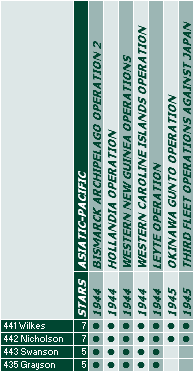Continuing west in support of General MacArthur’s series of landings across northern New Guinea, the division participated in the operations at Hollandia, Wakde (less Swanson), Biak, Noemfoor and Cape Sansapor, with Swanson serving as flagship of Rear Admiral Daniel E. Barbey’s Task Force 77, the Attack Force.
In late August, it left New Guinea to join VAdm. Marc Mitcher’s Fast Carrier Task Force 38.
Operating with DesRon 6, Wilkes, Nicholson and Swanson joined Rear Admiral Ralph E. Davison’s Task Group 38.4 screening carriers Franklin, Enterprise San Jacinto and Belleau Wood, which launched air strikes on the Bonins, Ulithi, Yap, Palau, Okinawa and Taiwan and provided air support for the Philippine landings on 20 October.
Operations of destroyers
attached to Division 24
in 1944-45

Grayson, meanwhile, was attached to VAdm. John S. McCain’s Tast Group 38.1, operating with DesRon 12 in the screen of carriers Wasp, Hornet, Monterey and Cowpens. On 14 September, she, Farenholt and McCalla bombarded a radar station at Mindanao’s Davao Gulf, the first such action against a target in the Philippine Islands.
In October, her task force also struck Okinawa and the Philippines. On the 14th, Grayson was in formation with McCalla escorting Cruiser Division 10 off Formosa when Houston (CL 81) was torpedoed. While Boston (CA 69) took her under tow, Grayson, Cowell and Boyd conducted rescue operations and escorted the slow-moving “CripDiv” until relieved two days later.
At Leyte, the Wilkes-Nicholson-Swanson task group first assisted in turning back the Japanese Central Force at the Battle of the Sibuyan Sea on 24 October and then raced north to intercept the Japanese decoy force of carriers at the Battle off Cape Engaño, Luzon.
On 3 November, Wilkes and Nicholson returned to Guam, escorted convoys to Manus and Eniwetok and then went home for overhaul. Steaming back to the war zone in February 1945, the two screened New Mexico to Ulithi in March and then escorted a convoy to Okinawa. There during the invasion they took station off Kerama Retto, covered carriers during strikes on the Nansei Shoto and then continued operating with the Third Fleet through the surrender. They remained in the western Pacific after the surrender, departed for home in October and arrived on the West Coast in November.
Swanson and Grayson, meanwhile, operated from Saipan on radar picket and lifeguard duty before returning to the West Coast for overhaul in June 1945. Both took departure again for the western Pacific but arrived too late for further wartime operations.
Sources: Destroyer History Foundation database, Roscoe, Morison, Dictionary of American Naval Fighting Ships entries for individual ships.